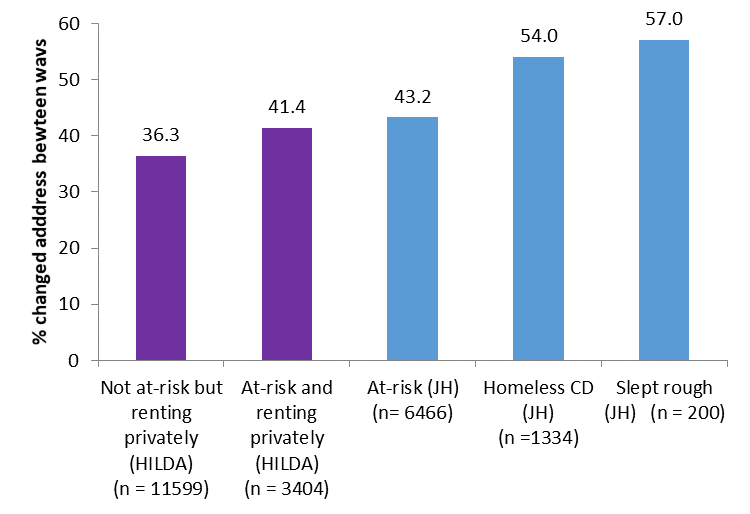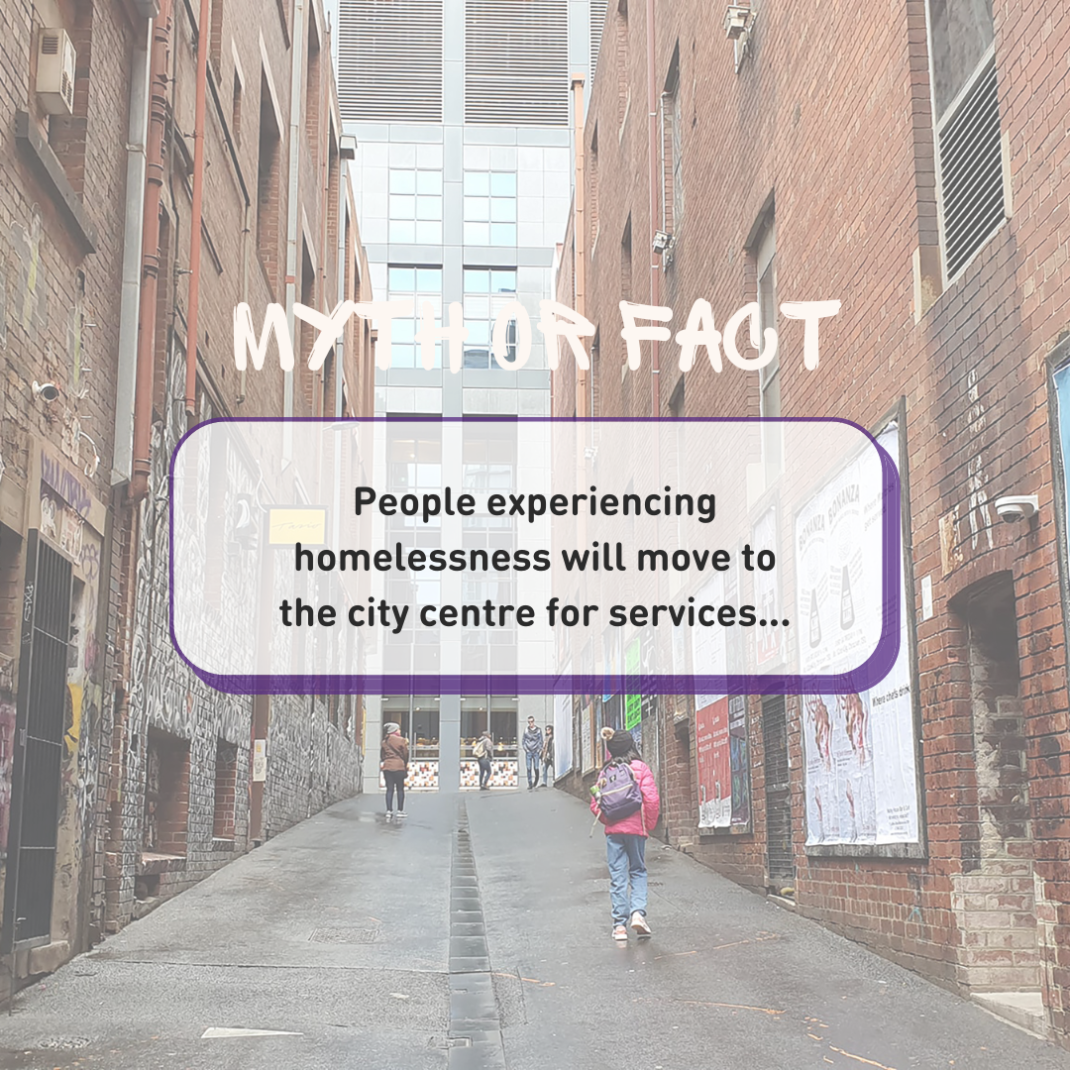Myth busting: Do people experiencing homelessness gravitate to cities?
June 7 2023
Deb Batterham is a Post-doctoral Research Fellow at the Centre for Urban Transitions, Swinburne University and a member of the Launch Housing Research, Evaluation and Data team.
It is often assumed that people experiencing homelessness gravitate to large cities and central city areas because of the concentration of support services – a so-called magnet or honeypot effect.
Rather than framing these moves as a reasonable attempt to exit homelessness, the narrative typically casts this as people ‘taking advantage’ of inner-city area services and the generosity of residents. Services are often portrayed as misguided and supporting homeless ‘lifestyles’, a narrative, which actually undermines efforts to assist people experiencing homelessness.
Interestingly, little is actually known about how people experiencing homelessness move across space over time. My recent research sought to explore these assumptions, guided by the question:
How and why do people who are homeless, or at-risk of homelessness, move across space and what are the characteristics of the areas they move between?
What was my research approach?
I compared the mobility of four groups across Australia : people experiencing homelessness; people identified as being at-risk of homelessness; people renting in the private rental market – who are known to move more frequently than owner occupiers (Clark & Morrison, 2012), and people sleeping rough within the broader homeless population.
I explored how many people moved, how far and the boundaries they crossed. I looked at reasons for moving and whether, this is to areas with different characteristics, such as more homelessness services and cheaper rental housing.
I used data from two longitudinal Australian surveys: The Household Income and Labour Dynamics in Australia (HILDA) survey and Journeys Home. Both follow people over time, collecting information including where they are living, if they’ve moved, where from, and reasons for moving on either annually or biannually.
How did I define homelessness?
I used two definitions – the first frames homelessness as a form of poverty or capability deprivation (Batterham (2019) – a person is homeless if they are in a living situation which lacks basic stability and/or involves violence or abuse and/or where the dwelling is inadequate to the point of endangering their health or survival, because they lack access to other more adequate living situations. The second was the cultural definition of homelessness (Chamberlain & MacKenzie, 1992), which holds that a person is homeless if their housing falls below a minimum cultural standard. Both definitions gave the same pattern of results.
To define being at-risk of homelessness I used my earlier work (2019; 2021) which argues that experiencing more than one of five things below makes a person at-risk: low or low unstable income; vulnerability to discrimination; the need for support to access or maintain a living situation; limited social resources and supports; and a tight housing market. I also excluded people in owner occupied housing and some other groups (see Batterham, 2021 for details).
I defined mobility as having changed address or sleeping location between consecutive waves of either survey (Journeys Home or HILDA).
What did I find?
How likely and how far do people move?
Not surprisingly, those at-risk of homelessness are more likely to change address compared to those not at-risk but renting. People who are homeless are more likely to move, especially if they are sleeping rough, as shown in Figure 1.
Figure 1 Percentage of people changing address between waves by homelessness and risk status in both Journeys Home (2011-2014) and HILDA (2012-2014) Australia

Source: Batterham, 2022. Author’s calculations using Journeys Home Limited Release +RED dataset and HILDA 15 limited release dataset
Note: As data from both the HILDA and Journeys Home panels is used, different colours have been used for the bars to denote different data sources. This is important as HILDA waves are annual and Journeys Home waves are six monthly. A set of chi square and t-tests were run to assess the statistical significance of these differences. Results are available from the author on request.
On average, all groups moved similarly short distances. This is consistent with existing research that shows renters tend to make multiple short distance moves compared with homeowners (Clark & Morrison, 2012).
I found most moves involve a change of suburb, but the majority of moves stay within a labour market area and greater capital city or rest of state area. There was some evidence that people sleeping rough are more likely to move into or out of capital city areas are, but numbers for this group were small in the survey used and more work is needed (people sleeping rough only make up 7% of the overall homeless population at a point in time as defined by the ABS (ABS, 2018).
Why do people move?
While people in all groups moved for similar reasons, those at-risk of homelessness were more likely than those renting and not at-risk to move for negative reasons or reasons outside their control, such as eviction and relationship breakdown. They were also more likely to move to be closer to friends and family or get a place of their own. This is consistent with Clark’s (2011) work which found involuntary mobility was higher amongst people on low incomes, single parents and those in precarious housing situations. People not at-risk of homelessness were more likely to ‘move to improve’ (Clark, 2011), including to get married or move in with partner, get a better or larger place, or be nearer to work.
People experiencing homelessness were more likely to move because of relationship breakdown or conflict, domestic and family violence, other violence, and because they had been evicted. People sleeping rough were even more likely than others experiencing homelessness to move to escape violence (family or otherwise) and due to problematic drug or substance use.
Do people move to areas with more homelessness services?
Results suggested that people at-risk move to areas they can afford, which tend to be more disadvantaged than the areas they were in, with higher unemployment but more rental housing.
When people experiencing homelessness changed suburb, they moved between similar areas (in terms of disadvantage, unemployment rates, median incomes, amount of private rental housing, median rents etc). Importantly, I found no significant difference between the homelessness service capacity and rates of homelessness between the areas people moved to and from. Moving did not seem to be concentrating people experiencing homelessness into specific types of areas.
Importantly, overall, people at-risk of homelessness tended to live in areas with relatively lower household incomes, lower rents and more affordable private rental stock, compared to people renting but not at-risk.
What does this mean for the ‘magnet hypothesis’, policy and services?
There is no evidence to suggest that people experiencing homelessness gravitate to areas rich in homeless services. This group moves for a variety of reasons, but particularly because they are forced to through eviction, relationship breakdown and violence. This is not to say that some people will not move to central city areas, but some also move out of these areas and overall this research suggests these moves cancel out.
Given the largely short distance moves among people experiencing or at-risk of homelessness, locating services and prevention initiatives in areas with higher homelessness, and a larger population of people at-risk of homelessness, makes good sense.
That people at-risk tend to move to more disadvantaged areas with more rental housing is likely part of well-documented broader social and economic changes leading to concentrations of disadvantage in the middle and outer suburbs of Australia’s capital cities (Randolph & Tice, 2014). Policies designed to address income, wealth and housing inequality will be highly relevant for reducing both homelessness and risk of homelessness.
Overall, concerns about encouraging homelessness by providing services and support in central city locations further entrench stigma towards people who are already marginalised, rather than reflecting reality. While preliminary, I hope my work helps to challenge these unhelpful narratives, and informs evidence-based homelessness policy and services.
You can read the full paper here, via Taylor and Francis online.
References:
Baptista, I., Benjaminsen, L., & Pleace, N. (2015). Local Connection Rules and Access to Homelessness Services in Europe, EOH Comparative Studies on Homelessness. European Observatory on Homelessness
Batterham, D. (2019a). Homelessness as Capability Deprivation: A Conceptual Model. Housing Theory and Society, 36(3), 274–297.
Batterham, D. (2019b). Defining “At-risk of Homelessness”: Re-connecting Causes, Mechanisms and
Batterham, D. (2021). Who is At-risk of Homelessness? Enumerating and Profiling the Population to Inform Prevention. European Journal of Homelessness, 15(1), 59–83.
Clark, W. (2011). Mobility and Mobility Contexts: Modeling and Interpreting Residential Change in Australia. HILDA Survey Research Conference, Melbourne Australia,14‐15 July, 2011.
Clark, W., & Morrison, P. (2012). Socio-spatial Mobility and Residential Sorting: Evidence from a Large-scale Survey. Urban Studies, 49(15), 3253-3270.


